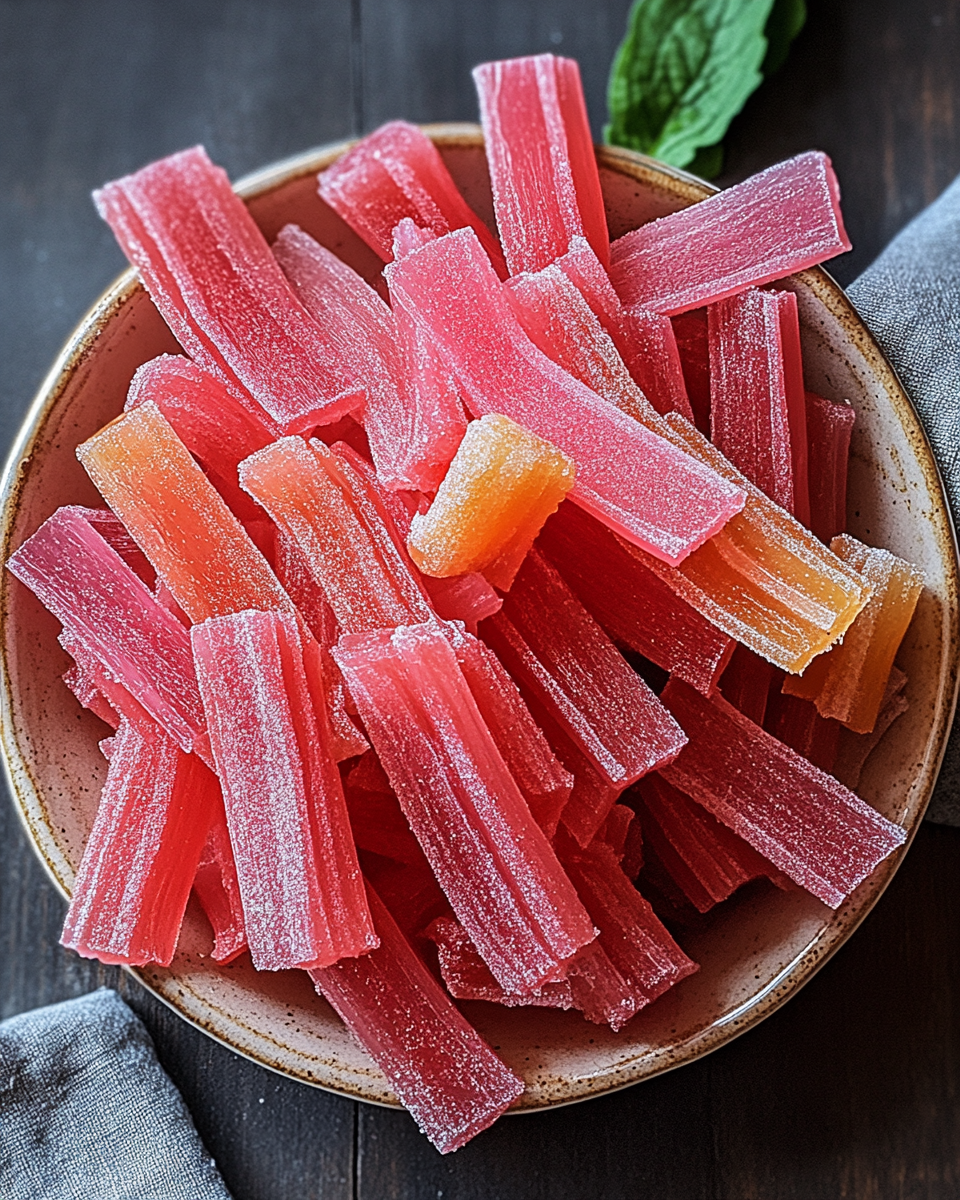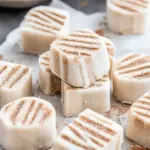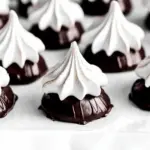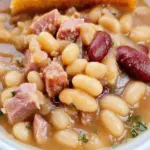The vibrant pink hue and delicate curl of these candied rhubarb ribbons make them a showstopper on any dessert table. Lightly poached in a sweet vanilla syrup, they hold just the right balance between tangy and sugary making them a delight both visually and on the palate.
These elegant strips can be used to top cakes, cupcakes, or even enjoyed as a refined snack. With minimal ingredients and an easy technique, this recipe transforms humble rhubarb into a work of edible art. Ideal for spring brunches, afternoon teas, or as a creative twist in your baking repertoire.
Full Recipe:
Ingredients:
-
4 stalks fresh rhubarb
-
1 cup granulated sugar
-
1 cup water
-
1 teaspoon vanilla extract
-
Parchment paper for drying
Directions:
-
Preheat your oven to 200°F (93°C) if using for drying, or prepare a clean drying rack.
-
Wash and trim the rhubarb stalks. Using a vegetable peeler or mandoline, slice long, thin ribbons from the stalks.
-
In a saucepan, combine the sugar, water, and vanilla extract. Bring to a simmer over medium heat, stirring until the sugar is fully dissolved.
-
Add the rhubarb ribbons to the syrup in batches and poach for 2-3 minutes until just tender.
-
Carefully remove the ribbons with tongs and lay flat on parchment-lined baking sheets or a drying rack.
-
Dry in the oven for 1 hour, flipping halfway through, or let air dry for 8–12 hours until they are firm but pliable.
-
Once dried, gently twist into curls or leave flat for a sophisticated garnish. Store in an airtight container for up to 1 week.
Prep Time: 15 minutes | Cooking Time: 1 hour (or air dry 8–12 hrs) | Total Time: ~1 hour 15 minutes
Kcal: 90 kcal | Servings: 4 servings
The Art of Making Candied Rhubarb: A Sweet Culinary Jewel
When it comes to spring and early summer produce, rhubarb is often a polarizing ingredient. Its vibrant crimson stalks, tartness, and versatility in sweet and savory dishes alike make it a favorite among chefs, home bakers, and food stylists. Among the many creative ways to showcase rhubarb, one preparation stands out for its beauty and elegance: Candied Rhubarb.
Candied rhubarb is more than just a recipe it’s a celebration of texture, color, and balance between tart and sweet. Often underestimated or used only as a supporting ingredient in pies and compotes, rhubarb truly gets its time to shine when candied. The process transforms tough, fibrous stalks into glossy, flexible ribbons that not only taste incredible but also serve as a stunning garnish for cakes, pavlovas, custards, and more.
In this article, we delve deep into the background, techniques, uses, and cultural relevance of candied rhubarb, providing insight and inspiration to help elevate your next dessert presentation.
Understanding Rhubarb
To fully appreciate candied rhubarb, it’s helpful to first understand the unique nature of the plant itself. Rhubarb is botanically a vegetable, though it is typically treated as a fruit in culinary contexts. Its vivid stalks range from pale pink to deep crimson, while the leaves though striking are inedible due to their high levels of oxalic acid.
Rhubarb thrives in cool climates and is most abundant from April to early summer. While raw rhubarb is highly acidic and unpleasantly sour, it mellows beautifully when cooked or sweetened, making it a versatile base for jams, sauces, pies, and candying.
Candied rhubarb takes this transformation one step further. The sugar syrup softens the fibrous texture while simultaneously infusing sweetness and preserving the vibrant color. It’s a fantastic method for extending rhubarb’s short season by turning it into a long-lasting confection.
The Technique Behind the Elegance
Candying rhubarb is both an art and a science. It begins with selecting the freshest stalks brightly colored, firm, and free of blemishes. The rhubarb is then sliced into thin ribbons using a vegetable peeler or mandoline. These ribbons are gently simmered or soaked in a sugar syrup, which both softens and sweetens them.
Some recipes suggest dehydrating the ribbons in a low oven or leaving them to air dry, allowing them to curl naturally into beautiful spirals. This creates a chewy, almost fruit-leather-like texture that is ideal for both garnishing and snacking.
The real allure of candied rhubarb lies in its appearance. Once dried, the ribbons become semi-translucent, almost jewel-like. Their intense pinks and reds glisten under natural light, making them perfect for decorative plating. They are not only edible but elevate the aesthetic of any dessert they accompany.
Uses in Modern Cuisine
Candied rhubarb’s elegance and versatility make it a favorite among pastry chefs and food stylists. It can be used in various ways, both as a centerpiece and a garnish.
-
Cake decoration: Wrap spirals of candied rhubarb around the top of a frosted cake for a whimsical, floral appearance. It’s particularly popular with springtime bakes like vanilla sponge, lemon cake, or strawberry-rhubarb chiffon.
-
Pavlova topper: Place candied rhubarb curls atop meringue and whipped cream for a dramatic pop of color and an added chewy texture.
-
Cocktail garnish: Use a strip of candied rhubarb as an elegant stirrer or curl it around the rim of a cocktail glass for a fresh twist.
-
Yogurt or oatmeal topping: Add a sweet crunch to your breakfast bowl by scattering ribbons on top of yogurt parfaits, chia pudding, or warm oatmeal.
-
Snack on its own: It’s healthy-ish, sweet, and unique an artisanal fruit leather substitute.
Because it is so lightweight and keeps well when stored properly, candied rhubarb also makes a wonderful edible gift. Packaged in cellophane bags or decorative jars, it offers a rustic yet elegant treat that reflects thoughtfulness and creativity.
A Nod to History and Tradition
While candied rhubarb feels like a modern creation, candying fruits is an ancient technique. The practice dates back centuries as a method of preservation. In medieval Europe and the Middle East, fruits were often candied in sugar or honey to store them for long journeys and harsh winters.
Rhubarb itself has a fascinating global history. Native to China, it was originally used for medicinal purposes and later introduced to Europe via the Silk Road. By the 18th century, rhubarb had found its way into English gardens, and from there, into kitchens across the world.
Today, candying rhubarb connects these traditions to contemporary cuisine. It represents the intersection of preservation, presentation, and innovation qualities that make it an enduring favorite in both home and professional kitchens.
Tips for Success
Creating beautiful candied rhubarb takes some finesse. Here are a few expert tips to ensure your ribbons come out perfect every time:
-
Use a very sharp peeler or mandoline: The thinner the slice, the more easily the rhubarb will candy and curl without cracking.
-
Don’t overcook: A quick blanch or soak in warm syrup is usually enough. Overcooking will cause the strips to break or become mushy.
-
Dry thoroughly: Whether using an oven at low temperature or air drying overnight, make sure the ribbons are no longer tacky before storing.
-
Store in an airtight container: Moisture is the enemy of candied fruits. Keep them sealed in a cool, dry place to extend shelf life and preserve texture.
Additionally, you can experiment with flavor infusions. Add a touch of vanilla, rose water, lemon zest, or even a splash of orange liqueur to the syrup to give your candied rhubarb a personalized twist.
Pairing Possibilities
Because of its vibrant acidity and sweet tang, candied rhubarb pairs beautifully with a variety of flavors and textures:
-
With creamy elements: Think panna cotta, cheesecake, or crème brûlée.
-
With chocolate: Its tartness offsets the richness of dark or milk chocolate desserts.
-
With citrus: Combine it with orange or lemon curds for a fresh, bright combo.
-
With nuts and spices: Add candied rhubarb to nutty granola or spiced tarts for a layered flavor profile.
The possibilities are endless. Whether you’re looking to impress dinner guests or simply want to elevate a simple dessert, candied rhubarb adds both flavor and finesse.
Conclusion:
Candied rhubarb is more than just a pretty garnish it’s a celebration of seasonality, creativity, and the magic of simple ingredients transformed with care. From its humble beginnings as a tart garden vegetable to its status as an edible work of art, rhubarb proves that the best dishes often come from unexpected places.
Incorporating candied rhubarb into your culinary repertoire allows you to honor tradition while embracing innovation. It’s a perfect way to make your desserts unforgettable both visually and in flavor.
Whether you’re a seasoned baker, a home cook, or just someone looking to try something new, candied rhubarb offers a delightful experience that captivates the senses and leaves a lasting impression.






